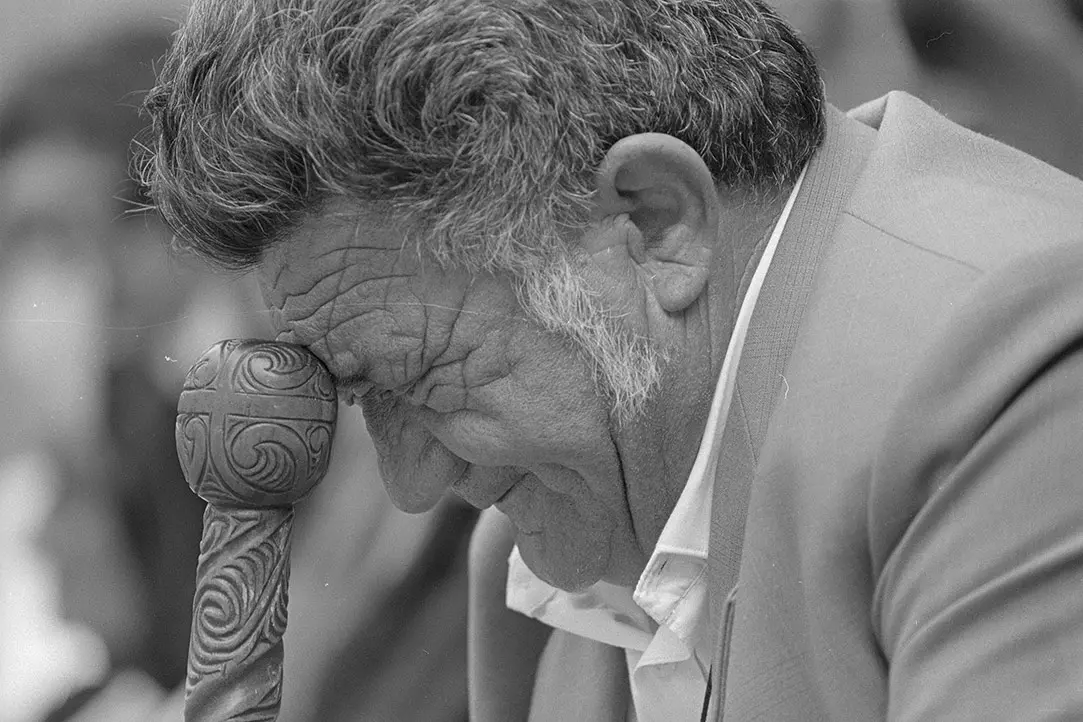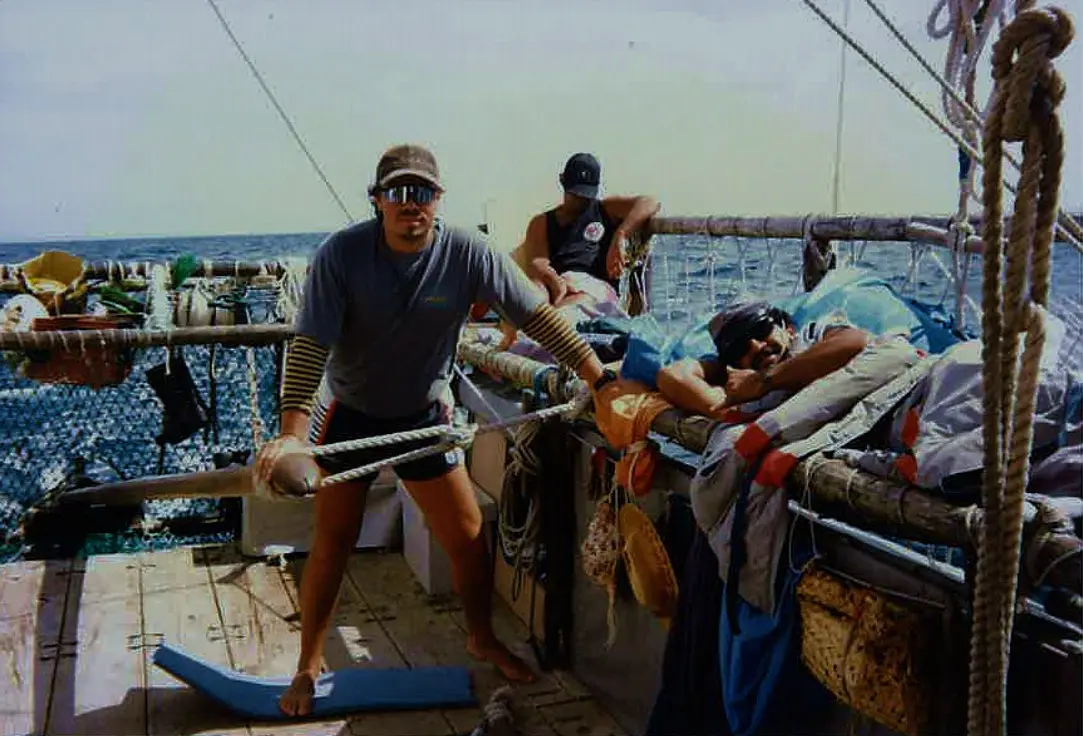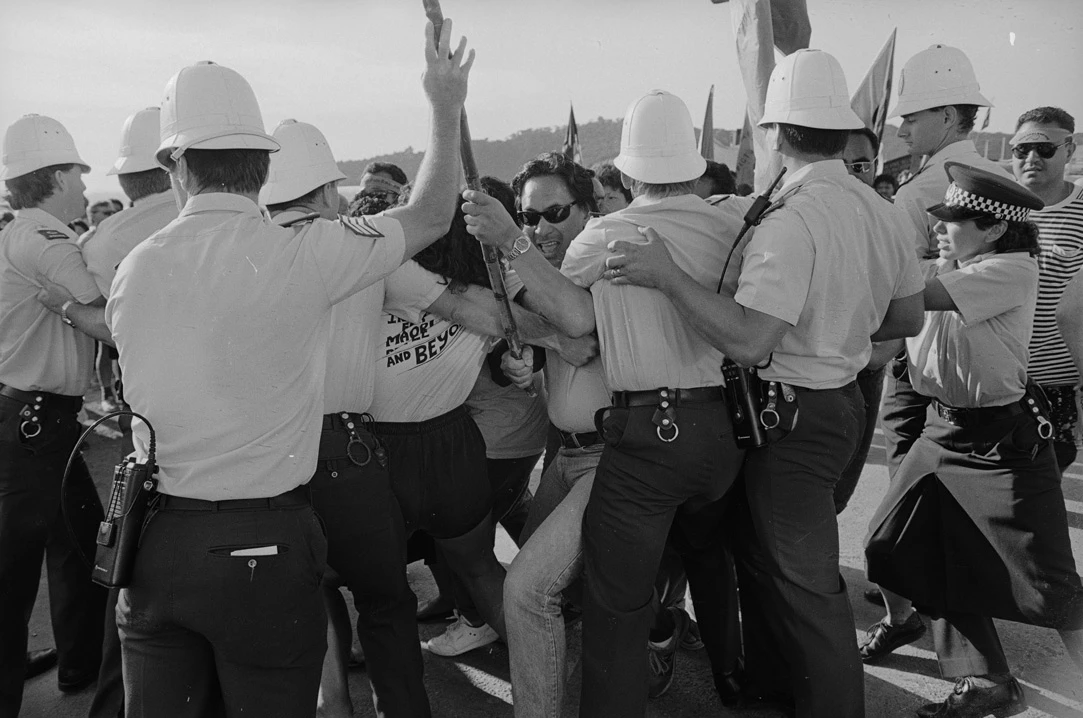Waitangi Day: Rā maumahara, rā whakanui
There have been many memorable Waitangi Days. This year is an opportunity to reconsider this special event. COVID-19 has changed us, yet this day remains a signpost of where we've come from and where we're heading. Read more and explore our resources.
I orea te tuatara ka patu ki waho.
Problems can be solved by continuing to pursue solutions.

Image credit: Mr Mac Taylor, Ngāpuhi elder, at the Treaty of Waitangi commemoration church service, Waitangi, 1987 by Evening Post staff photographer. Ref: EP/1987/0630/25-F Alexander Turnbull Library. Some rights reserved.
New beginnings
I remember the first time I went to Waitangi. The year was 1996 and I was on the verge of my first year at varsity. Through some waka ama connections, my own persistence and some desperation on the part of those in charge, I’d managed to get a crew spot on the voyaging waka Te Aurere, which was based in the Bay of Islands.
The captain and navigator of Te Aurere was Jack ‘Jacko’ Thatcher (Ngāi Te Rangi, Ngāti Ranginui, Ngāti Porou, Te Aitanga-a-Hauiti). The celebrated Master 'Pwo' Navigator was planning to sail down the coast to Tauranga and had given me an opportunity to be on board. At the time, I didn’t realise how much that would impact my future.
Aside from the life-changing experience of sailing on Te Aurere, I experienced other things that weekend that would run alongside my love of waka and the mōana, as a separate yet intersecting experience.

Image credit: Author aboard Te Aurere, 1996.
First Waitangi Day encounters
I arrived in Paihia to join Te Aurere on 4 February. I had scant knowledge of the significance of the events that I would witness two days later, nor the historical background around Te Tiriti o Waitangi and Waitangi Day. I may have been 'green', but I was hungry to understand — everything.
As I busied myself trying to learn all I could about the waka, I noticed that many others had begun to arrive on what must have been 5 February. When I remarked on this, a more experienced crew member by the name of Pauly said, ‘Waitangi Day!’ with an incredulous look that kinda said, ‘Are you a complete idiot?’
That night, we gathered at Te Tī marae along with others — mostly Māori, some Pākehā and some young European tourists along for the vibe. There were speeches, flags and raised voices. Then Ngāi Tūhoe arrived. They poured the appropriate amount of fuel on the fires. There was an intense feeling of determination in the air.
I’d never been exposed to such visceral mamae (pain) and riri (anger) like I witnessed that night. There was an outpouring of rage and defiance. Tears streaming down faces, accompanied by wailing that seemed 'straight outta 1840'. Sounds of quiet weeping were equally unsettling and resonated with old hurt, promises and assurances made by the Crown that had been broken, repeatedly.
The protest hīkoi to take place the next day would attempt to bring the group's concerns before government representatives on the very lawn where Te Tiriti o Waitangi was first signed.

Image credit: Waitangi Day protester Ben Dalton being restrained by police, Waitangi, 1990 by Ross Giblin, Evening Post. Ref: EP/1990/0499/E Alexander Turnbull Library. Some rights reserved.
Waka and protest: An uneasy mix
Six years earlier in 1990, Bishop Whakahuihui Vercoe (Ngaitai, Ngāi Tuhoe, Te Arawa, Whakatōhea) delivered an infamous address to the Crown on the Treaty Grounds. The speech that Waitangi Day more than captured the attention of all who heard it and left no one in doubt about the feelings of tangata whenua. I encourage you to watch a video of the speech on Te Ara.
The protest group that I was seeing would attempt to march across the bridge from Te Tī and confront the perpetrator of wrongdoing — the breaker of promises and ‘thief’ of tribal lands and futures, the Crown — as Bishop Vercoe had done. I was determined to be there.
The next morning, I shared my intentions with the waka crew. Again, from Pauly, that look!
‘Waka people don’t take part in protests,’ he said.
‘Why?’ I asked carefully.
Putting down his breakfast bowl, I could see Pauly reaching down deep and drawing up a bucket from a ‘well’ within. Before I share his words with you, I want to talk about that well.
Discovering the well
I’ve journeyed alongside Māori friends and colleagues for nearly 35 years. Those journeys have taught me a great deal. What’s been inescapable for me is the well that sits as a foundation inside my friends as members of iwi and hapū. They are the inheritors and guardians of all that has gone before them.
For them, colonisation isn’t a topic that might be encountered as part of their studies. For them, who were dispossessed of their lands, language and the ability to sustain their social, cultural and economic viability, the struggle against colonisation and its ravages seems endless.
After all I’ve learned about what tangata whenua have had to endure and continue to endure as a result of the arrival of te ao Pākeha, it overwhelms me that tangata whenua retain the capacity to forgive and be gracious. Our world landed upon theirs and purposefully, angrily and brutally swept it aside.
Our place in Aotearoa was secured not by our supposed superiority. It wasn’t even secured decisively by military might. The ascendancy of te ao Pākehā owes more to the sheer numbers of settlers and to multiple pieces of legislation, policy and government instruments that advantaged their visions and treated tangata whenua as lesser members of the new society.
Two examples that come to mind are the New Zealand Constitution Act 1854 and the New Zealand Settlements Act 1863 (YouTube video, 0:51) that ensured Pākehā society would rise and tangata whenua would be their footstool.
Yet despite this, within my friends and colleagues is a well. I’m talking of a deep reservoir of patience, endurance and faith. I’m reluctant to describe it, for fear that I might misrepresent it. However, it’s something that’s really important to acknowledge and to honour. With it comes an amazing capacity to teach, share and instruct those of us who are ready to listen.
Wise and careful counsel
Back to the morning of 6 February and me and Pauly.
‘Tereora!’ he said with a calm authority. ‘Waka crew don’t protest, we hoe (paddle) like our tīpuna did. Hek is a “royalist” and doesn’t support the protests.’
He was, of course, referring to renowned master waka builder and Ngā Puhi kaumatua, Heke Busby.

Image credit: Hekenukumai Busby with the twin-hulled waka Te Aurere, Wellington, 1998 by Melanie Burford, Evening Post. Ref: EP/1998/0365/33 Alexander Turnbull Library. Some rights reserved.
Sir Hekenukumai Busby (Te Uri o Hina, Te Rarawa), as he became later, had researched, designed and built Te Aurere to revive a proud Māori maritime tradition but also to take part in the 1992 Pacific Festival of the Arts in Rarotonga. This festival would host, for the first time in centuries, a flotilla of voyaging canoes built by Oceanic nations to honour and celebrate an ancient seafaring history. Sir Heke Busby's work significantly contributed to the revival of waka in Aotearoa and beyond.
He went on, ‘We paddle and sail waka, that’s what we do, that’s us honouring Te Tiriti.’
I was confused. ‘How could you not support the protest?’ I couldn’t reconcile then what I had heard.
But I can today. On 6 February 1996, those paddling waka were doing something completely different to their whanaunga (kin/relatives) standing on the bridge facing a police detachment in full riot gear.
It's obvious to me now that both groups were doing exactly what they determined their tīpuna would have done. I never saw the two groups argue. There was a quiet commitment to ‘You do you, and I’ll do me’.
That day, I was with both groups. I don’t claim to have completely understood all that I was part of as I worked on the waka but also stood with the protest group. I just wanted to show my face and lend my support.
‘Showing up,’ my grandmother would say, ‘is 90% of fixing anything.’
The ‘here and now’
We’ve been through a lot as New Zealanders over the past few years. The Christchurch earthquakes, the 2019 Mosque attacks, the eruption of Whakaari, and now the pandemic. Our ability to be ‘the team of 5 million’ has been challenged. Indeed, some among us have been broken and many bruised by our recent journey in waka Aotearoa.
There’s much to keep us from thinking about or even attending Waitangi Day this year. The storms have been long and our ‘hope tanks’ might be running low.
But that’s what makes this 6 February so important.
This Waitangi Day
Observing the journey of my Māori friends has taught me that the measure of your resilience is in every way equal to the dimensions of what you’ve had to endure. And that hope in what might be, or in a promise yet to be fulfilled, can be the difference between your waka reaching its destination or coming apart in the storm.
The 540 signatures of rangatira Māori are not only an amazing gift of citizenship but allow us to appreciate and reflect upon the cost of that gift and the opportunities that await us when we honour each other.
I intend to use this Waitangi Day to consider this gift of citizenship and to continue exploring ways to honour the privileges that it affords us.
On 6 February, I encourage you to do the same.
Te Tiriti summons us all back to the agreement, as it has always done.
Mauriora!
Author’s update 2023
Revisiting this blog post that I wrote in 2022, I thought I would try my best to add a fresh reflection as we approach a new Waitangi Day in 2023.
In last year's conclusion, I talked about Māori resilience and the endurance of my friends who continue to pursue positive aspirations about Te Tiriti and our relationships based upon that agreement. But what about us, what of our resilience?
We are wrestling with many issues in a post-COVID environment. Those of us in rain-affected areas are having our fortitude tested as we face sodden and flood-damaged houses, roads and neighbourhoods.
As 6 February approaches this year, I find myself reflecting on this question, ‘Is Waitangi Day the point, or is its importance found in how it might remind us of things more profound?’
I would argue that the 540 rangatira who signed Te Tiriti and those who signed on behalf of the Crown, did so with hopes of what would come after their affirmations in ink. They hoped for continued prosperity and trade, for peaceful relations and for their respective positions of authority that Te Tiriti affirms.
Waitangi Day is an opportunity to reflect on those aspects of history. The rest of the year allows us the opportunity to put some of those thoughts into practice in ways that are meaningful, sustainable and move us forward together.
Tēnā tātou i tēnei Rā Maumahara, Rā Waitangi 2023!
Find out more
Here are some resources related to Te Tiriti o Waitangi | the Treaty of Waitangi.
National Library resources
He Tohu has:
Topic Explorer has:
Many Answers has:
Read these stories with resources from Te Kupenga online:
Blog posts:
Resources from other organisations
E-Tangata: Becoming ‘really Pākehā’
Newsroom: Becoming Pākehā
Heritage New Zealand: Te Rā o Waitangi | Waitangi Day booklet
Ngā Taonga Sound & Vision: Reflecting on Waitangi
Te Papa Tongarewa: He puka mahi Rā o Waitangi | Waitangi Day activity book
Waitangi Treaty Grounds: Resources and activities
Well done! A great first Blog!
Very professional and well rounded!